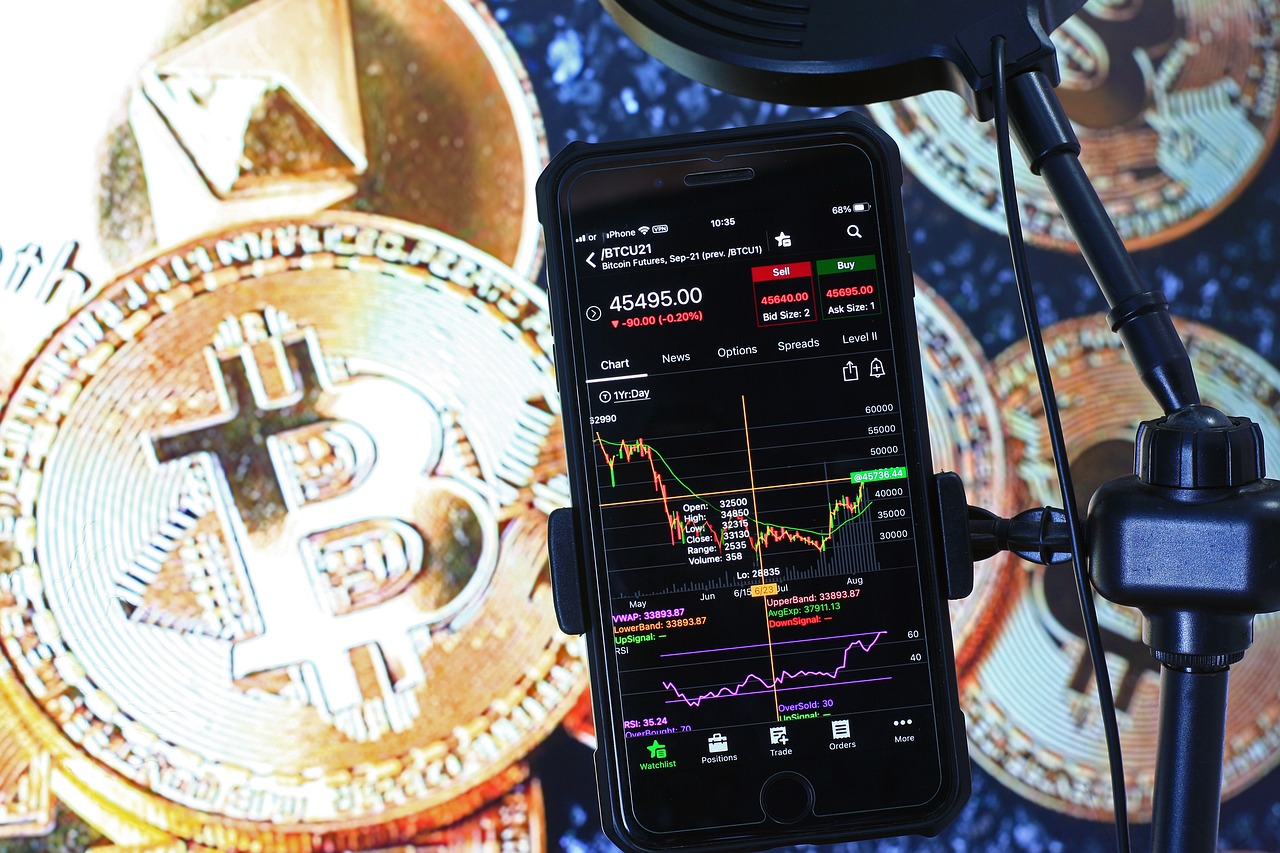How to Navigate the Crypto Market During Volatile Times
The cryptocurrency market can feel like a rollercoaster ride, with its wild ups and downs that can leave even the most seasoned investors feeling dizzy. But don't worry! This article is here to guide you through the unpredictable nature of crypto trading, especially during those nail-biting moments of high volatility. Think of it as your trusty roadmap, helping you navigate through the twists and turns of the market, ensuring that you make informed decisions rather than emotional ones. After all, in a world where prices can skyrocket or plummet in the blink of an eye, having a solid strategy is your best defense against potential losses.
So, how do you keep your cool when the market feels like it's in freefall? It all starts with understanding what volatility really means. Market volatility refers to the rapid and significant price movements in cryptocurrencies. Imagine standing on the edge of a cliff, looking down at the churning sea below; that’s what volatility feels like. By grasping the causes of these price swings, you can better anticipate changes and position yourself to take advantage of opportunities rather than be swept away by panic.
In this article, we’ll delve into essential strategies for risk management, emotional discipline, and the importance of staying informed. You’ll discover how diversifying your portfolio can act as a safety net, how to use technical analysis to make educated trades, and how to maintain your composure amidst the chaos. By the end, you’ll feel empowered to tackle the crypto market with confidence, regardless of how turbulent it may become.
Market volatility is like the weather; it can change unexpectedly and dramatically. One moment, the sun is shining, and your investments are soaring; the next, a storm rolls in, and everything feels uncertain. Understanding the factors that contribute to market volatility is crucial. These can include global economic news, regulatory changes, technological advancements, and even social media trends. For instance, a tweet from a prominent figure can send prices soaring or crashing within minutes. By keeping an eye on these influences, you can better prepare for the inevitable ups and downs.
When it comes to investing in cryptocurrencies, having a solid risk management strategy is like wearing a life jacket on a boat—it's essential for your safety. Without it, you might find yourself in a precarious situation. One of the most effective ways to manage risk is through diversification. Think of your investment portfolio as a fruit basket; if you only have apples and one goes bad, your entire snack is ruined. However, if you have a mix of apples, bananas, and oranges, you can still enjoy a tasty treat. By spreading your investments across different cryptocurrencies, you can reduce the impact of any single asset’s poor performance.
Diversifying a cryptocurrency portfolio can help mitigate risks associated with market fluctuations. This strategy involves spreading investments across different assets to reduce exposure to any single asset's performance. It’s not just about quantity; it’s about quality too. When selecting diverse assets, consider factors like market trends, historical performance, and the underlying technology of the cryptocurrencies. For example, investing in both established coins like Bitcoin and emerging altcoins can balance your risk and potential rewards.
Selecting diverse assets based on market trends and fundamentals can enhance a portfolio's resilience. Look for cryptocurrencies that align with your risk tolerance and investment goals. If you’re more risk-averse, you might lean towards established coins with a history of stability. Conversely, if you’re open to taking risks for potential high rewards, you might explore newer projects with innovative technology. Remember, the right mix can make all the difference in weathering market storms.
Regularly rebalancing your portfolio ensures that asset allocations remain aligned with your investment objectives. Imagine you’re a captain steering a ship; if you don’t adjust your course based on changing winds, you might end up lost at sea. Periodic assessments and adjustments in response to market changes are crucial for maintaining a healthy investment strategy. This could mean selling off some assets that have performed well and reallocating funds into those that may have more growth potential.
Technical analysis involves evaluating price charts and market trends to make informed trading decisions. It's like being a detective, piecing together clues to predict future price movements. Essential tools and indicators, such as moving averages and RSI (Relative Strength Index), can help you identify trends and potential entry or exit points. While it may seem complex at first, mastering these tools can give you an edge in making timely trading decisions.
Maintaining emotional discipline is vital during volatile market conditions. It’s easy to get swept up in the excitement or fear that can come with rapid price changes. One moment you might feel like a genius for making a profitable trade, and the next, you could be paralyzed with fear after a sudden drop. To combat this, it’s essential to establish realistic trading goals. Think of them as your guiding stars; they’ll help you stay focused and reduce anxiety during market fluctuations.
Establishing realistic trading goals helps maintain focus and reduces anxiety during market fluctuations. Instead of aiming for unattainable gains, set achievable milestones that align with your risk tolerance. This way, you’ll be less likely to make impulsive decisions driven by fear or greed. Remember, investing is a marathon, not a sprint; patience and discipline are key.
Fear of missing out (FOMO) and panic selling can lead to poor investment decisions. When you see others profiting, it’s tempting to jump in without a plan. Recognizing these emotions is the first step in staying grounded. Techniques such as setting predetermined price points for buying or selling can help you stick to your strategy, even when the market feels chaotic.
Continuous education and staying updated on market trends are essential for navigating volatility. Knowledge is power, especially in a fast-paced market like cryptocurrency. Follow reliable sources, engage with communities, and keep learning. The more informed you are, the better equipped you'll be to make sound trading decisions, even when the market is throwing curveballs.
- What is market volatility? Market volatility refers to the rapid and significant price movements in the cryptocurrency market.
- How can I manage risks in crypto trading? Effective risk management strategies include diversification, regular rebalancing, and setting realistic trading goals.
- Why is emotional discipline important in trading? Emotional discipline helps prevent impulsive decisions driven by fear or greed, allowing for more rational trading choices.
- What role does education play in crypto trading? Staying informed and continuously educating yourself about market trends can enhance your trading strategies and decision-making process.

Understanding Market Volatility
Market volatility is like a roller coaster ride, filled with thrilling ups and downs that can leave even the most seasoned investors feeling a bit queasy. But what exactly is it? In simple terms, market volatility refers to the rapid and significant price movements of cryptocurrencies. These fluctuations can happen in the blink of an eye, influenced by a myriad of factors, from market sentiment to regulatory news. Understanding these causes is crucial for investors looking to navigate the unpredictable waters of the crypto market.
One of the primary drivers of volatility is market sentiment. When investors feel optimistic, prices can skyrocket; conversely, fear and uncertainty can lead to sharp declines. For example, a positive announcement from a major tech company about adopting blockchain technology can send prices soaring, while news of regulatory crackdowns can trigger a mass sell-off. It's essential to stay attuned to the news and market trends, as they can be the difference between riding the wave of success and getting caught in a downturn.
Another significant factor contributing to volatility is the liquidity of the market. Cryptocurrencies are often traded in smaller volumes compared to traditional assets like stocks or bonds. This means that a single large transaction can have a disproportionate impact on the price. Imagine a small pond where a big splash can send ripples across the entire surface; that’s how liquidity works in the crypto market. The less liquid an asset is, the more susceptible it is to dramatic price swings.
Additionally, the speculative nature of cryptocurrency trading cannot be overlooked. Many investors are drawn to the market by the potential for high returns, often leading to speculative trading behaviors. This can create a feedback loop where rising prices attract more investors, further driving up prices until they eventually correct. Understanding this cycle is vital for anyone looking to invest in cryptocurrencies, as it highlights the importance of timing and market awareness.
To better illustrate the factors affecting market volatility, consider the following table that outlines key drivers:
| Factor | Description |
|---|---|
| Market Sentiment | The overall attitude of investors toward a particular cryptocurrency or the market as a whole. |
| Liquidity | The ease with which an asset can be bought or sold without affecting its price. |
| Regulatory News | Changes in laws or regulations that can impact the trading environment and investor confidence. |
| Speculation | Investors buying assets based on the belief that prices will rise, often without fundamental backing. |
In summary, understanding market volatility is crucial for navigating the unpredictable crypto landscape. By recognizing the factors that contribute to price fluctuations, investors can better anticipate changes and make informed decisions. So, whether you're a seasoned trader or just dipping your toes into the crypto waters, keep your eyes peeled and your mind sharp—because in this market, anything can happen!

Risk Management Strategies
When it comes to investing in the cryptocurrency market, particularly during those nail-biting moments of volatility, having a solid risk management strategy is your lifeline. Think of it as your safety net, designed to catch you before you hit the ground hard. The unpredictable nature of cryptocurrencies can leave even seasoned investors feeling like they’re on a roller coaster ride. So, how do you keep your cool and protect your investments? Let's dive into some effective strategies that can help you navigate these turbulent waters.
First and foremost, one of the most effective ways to manage risk is through diversification. Imagine you’re at a buffet; you wouldn’t pile your plate high with just one dish, right? The same principle applies to your investment portfolio. By spreading your investments across various cryptocurrencies, you reduce the impact of a single asset’s poor performance. For instance, if Bitcoin takes a nosedive, but your portfolio also includes Ethereum, Litecoin, and some altcoins, you might not feel the sting as much. Diversification not only helps in mitigating risks but also opens up opportunities for gains from different assets.
Now, while diversifying, it’s crucial to choose the right assets. Not all cryptocurrencies are created equal, and some may be more susceptible to volatility than others. Look for assets that have strong fundamentals, a solid use case, and a track record of resilience. A good practice is to analyze market trends and the overall sentiment surrounding different cryptocurrencies. By selecting a mix of established coins and promising newcomers, you're setting yourself up for a balanced portfolio that can withstand market fluctuations.
But wait, it doesn’t stop there! Regularly rebalancing your portfolio is another key aspect of risk management. Think of it as spring cleaning for your investments. Over time, some assets may perform better than others, leading to an imbalance in your portfolio. By periodically assessing your asset allocation and making necessary adjustments, you ensure that your investments remain aligned with your risk tolerance and financial goals. For example, if one cryptocurrency has skyrocketed and now makes up a larger percentage of your portfolio than intended, selling off a portion and reinvesting in underperforming assets can help restore balance.
In addition to these strategies, employing technical analysis can significantly enhance your decision-making process. By studying price charts and market trends, you can identify potential entry and exit points, helping you make informed trading decisions. Familiarize yourself with essential tools and indicators such as moving averages, Relative Strength Index (RSI), and Fibonacci retracement levels. These tools can provide valuable insights into market behavior, enabling you to anticipate price movements and react accordingly.
Finally, let’s not forget about the emotional aspect of trading. The crypto market can be a wild ride, and it’s easy to get swept away by fear or greed. This is where emotional discipline comes into play. Establishing realistic trading goals can help keep you grounded. Instead of chasing after every price spike, focus on your long-term vision. This mindset not only reduces anxiety but also helps you make more rational decisions, even when the market throws curveballs your way.
In summary, navigating the crypto market during volatile times requires a combination of smart risk management strategies. By diversifying your portfolio, choosing the right assets, regularly rebalancing, using technical analysis, and maintaining emotional discipline, you can better weather the storms of market turbulence. Remember, it’s not just about surviving the volatility; it’s about thriving in it!
- What is the best way to diversify a cryptocurrency portfolio? Diversification can be achieved by investing in a mix of established cryptocurrencies and promising altcoins across different sectors.
- How often should I rebalance my portfolio? It’s recommended to reassess your portfolio at least quarterly, or whenever there’s a significant change in market conditions.
- What tools can help with technical analysis? Popular tools include moving averages, RSI, MACD, and various charting platforms that provide real-time data.
- How can I maintain emotional discipline while trading? Setting realistic goals and sticking to a trading plan can help you avoid impulsive decisions driven by fear or greed.

Diversification of Portfolio
Diversification of a cryptocurrency portfolio is like creating a safety net for your investments. Just as a tightrope walker wouldn’t balance on a single rope, savvy investors don’t put all their eggs in one basket. When it comes to the unpredictable world of cryptocurrencies, spreading your investments across a variety of assets can significantly reduce the risk associated with market fluctuations. Imagine if you invested solely in one cryptocurrency, and it plummeted overnight—your entire financial strategy would be at risk. However, by diversifying, you're essentially hedging your bets. If one asset falters, others may thrive, helping to cushion the blow.
But, how do you achieve effective diversification in the crypto space? It’s not just about buying random coins; it’s about strategically selecting a mix of assets that align with your investment goals and risk tolerance. For instance, you might consider including a combination of well-established cryptocurrencies like Bitcoin and Ethereum, alongside promising altcoins that have shown potential for growth. This blend can create a balanced portfolio that can weather the storm during turbulent market conditions.
To further illustrate the importance of diversification, let’s take a look at a simple example portfolio that includes various types of cryptocurrencies:
| Asset Type | Example | Percentage of Portfolio |
|---|---|---|
| Large Cap | Bitcoin (BTC) | 40% |
| Large Cap | Ethereum (ETH) | 30% |
| Mid Cap | Chainlink (LINK) | 15% |
| Small Cap | VeChain (VET) | 10% |
| Emerging Tech | Polkadot (DOT) | 5% |
In this example, the portfolio is diversified across different market capitalizations and sectors. The large-cap assets like Bitcoin and Ethereum are generally more stable, while the mid and small-cap assets can offer higher growth potential, albeit with increased risk. By maintaining this balance, investors can better navigate the ups and downs of the crypto market.
Moreover, diversification doesn't just stop at selecting different cryptocurrencies. It can also involve investing in other assets like stocks, bonds, or even real estate. This broader approach can further insulate your investments from the volatility inherent in any single market. Remember, the goal is to create a robust portfolio that can endure the unpredictable nature of the crypto landscape while still positioning yourself for potential gains.

Choosing the Right Assets
When it comes to investing in the cryptocurrency market, can feel like navigating a maze. With thousands of cryptocurrencies out there, each with its own unique characteristics and market behavior, making the right choice is crucial for your investment success. One of the first steps is to understand the fundamental aspects of the cryptocurrencies you are considering. This means diving deep into their technology, use cases, and the teams behind them. Are they solving real-world problems? Do they have a solid roadmap? These questions can guide you in selecting assets that have the potential for long-term growth.
Another important factor to consider is market trends. Keeping an eye on the current trends can provide insights into which assets are gaining traction. For example, during a surge in decentralized finance (DeFi) interest, assets related to that sector may show promising returns. On the flip side, if a particular sector is declining, it might be wise to reevaluate your holdings. Utilize tools like market cap rankings, trading volume, and price movements to gauge the popularity and stability of different cryptocurrencies.
Additionally, assessing your risk tolerance is vital. Not every investor has the same appetite for risk, and this should reflect in your asset choices. For instance, if you prefer a more conservative approach, you might want to focus on established cryptocurrencies like Bitcoin or Ethereum, which have a track record of stability. On the other hand, if you're more adventurous, exploring smaller altcoins with high volatility could yield significant rewards, albeit with higher risk. Here’s a quick breakdown:
| Asset Type | Risk Level | Potential Reward |
|---|---|---|
| Established Cryptocurrencies (e.g., Bitcoin, Ethereum) | Low to Medium | Steady Growth |
| Mid-Cap Altcoins | Medium | Moderate to High |
| Small-Cap Altcoins | High | Very High |
Finally, don’t ignore the community support behind a cryptocurrency. A strong, active community can be a good indicator of an asset's longevity and potential for growth. Engaging in forums, following social media channels, and participating in community discussions can provide valuable insights that you might not find in official reports or analyses. Remember, investing in cryptocurrencies is not just about numbers; it's about the people and the vision driving the technology forward.

Rebalancing Your Portfolio
Rebalancing your portfolio is like tending to a garden; it requires regular attention and adjustments to ensure that each plant thrives in harmony. In the world of cryptocurrency, where prices can swing wildly, maintaining the right balance of assets is crucial for achieving your investment goals. As market conditions change, the original allocation of your investments may no longer align with your risk tolerance or financial objectives. This is where the art of rebalancing comes into play.
Imagine you started with a portfolio that consists of 60% Bitcoin, 30% Ethereum, and 10% smaller altcoins. Over time, Bitcoin might surge to represent 80% of your portfolio due to its price increase, while your altcoins could dwindle in value. If you don’t rebalance, you’re essentially overexposed to Bitcoin, which could lead to significant losses if the market turns. By rebalancing, you would sell a portion of your Bitcoin and reinvest the proceeds into Ethereum and altcoins, bringing your portfolio back to the original allocations. This not only helps you manage risk but also allows you to capitalize on potential growth in different areas of the market.
But how often should you rebalance? While there’s no one-size-fits-all answer, many investors choose to reassess their portfolios on a quarterly or biannual basis. Others might opt to rebalance whenever their asset allocation deviates by a certain percentage, say 5% or 10%. The key is to find a strategy that aligns with your investment style and stick to it. Regularly rebalancing helps avoid emotional decision-making during market fluctuations and keeps your investment strategy on track.
To make the rebalancing process even more effective, consider these essential factors:
- Market Conditions: Be aware of the overall market trends. If a particular asset class is consistently underperforming, it might be wise to reduce exposure.
- Investment Goals: Revisit your financial goals regularly. If they change, your portfolio may need adjustments to reflect your new objectives.
- Tax Implications: Be mindful of the tax consequences of selling assets. Sometimes, it might be more beneficial to hold onto an asset to avoid capital gains taxes.
In essence, rebalancing your portfolio is not just a mechanical task; it’s a critical component of a successful investment strategy that helps you adapt to the ever-changing landscape of the crypto market. By staying proactive and making informed adjustments, you can enhance your portfolio's resilience and better position yourself for long-term success.
Q1: How often should I rebalance my cryptocurrency portfolio?
A1: While it varies by individual strategy, many investors rebalance quarterly or whenever their asset allocations deviate significantly from their target percentages.
Q2: What are the benefits of rebalancing?
A2: Rebalancing helps manage risk, ensures your portfolio aligns with your investment goals, and can enhance returns by taking advantage of market fluctuations.
Q3: Are there any tax implications to consider when rebalancing?
A3: Yes, selling assets can trigger capital gains taxes. It's essential to factor in tax implications when making rebalancing decisions.
Q4: Can I automate the rebalancing process?
A4: Yes, many investment platforms offer automated rebalancing features that can help you maintain your desired asset allocation without constant manual adjustments.

Using Technical Analysis
When it comes to navigating the choppy waters of the cryptocurrency market, technical analysis can be your best friend. Imagine you're a sailor, and the price charts are your compass. By understanding the patterns and signals in these charts, you can make informed trading decisions that could save you from the stormy seas of volatility. Technical analysis involves the study of historical price movements and trading volumes to predict future price action. It’s like being a detective, piecing together clues to forecast where the market might be headed next.
One of the fundamental tools in technical analysis is the use of charts. There are several types of charts, but the most popular ones among traders are line charts, bar charts, and candlestick charts. Each type provides unique insights into price movements and market sentiment. For instance, candlestick charts are particularly favored because they not only show the price movement but also reveal the open, close, high, and low prices within a specific timeframe. This can help you gauge market momentum and make better decisions.
Beyond just looking at charts, traders also rely on various indicators to enhance their analysis. Some of the most commonly used indicators include:
- Moving Averages: These help smooth out price action and identify trends over time.
- Relative Strength Index (RSI): This measures the speed and change of price movements, helping traders identify overbought or oversold conditions.
- Bollinger Bands: These indicate volatility and potential price reversals by showing the upper and lower bands around a moving average.
But remember, while technical analysis can provide valuable insights, it’s not foolproof. It’s essential to combine it with other forms of analysis, such as fundamental analysis, to get a holistic view of the market. Think of it like cooking a recipe; using just one ingredient might not yield the best dish. Instead, a mix of flavors (or in this case, analysis methods) can create a more robust trading strategy.
Furthermore, it’s crucial to stay disciplined when using technical analysis. Many traders fall into the trap of second-guessing their strategies based on emotional reactions to market movements. Having a clear plan and sticking to it, even in the face of volatility, can make all the difference. So, equip yourself with the right technical tools, keep your emotions in check, and you’ll be well on your way to navigating the crypto market like a pro!
Q1: What is technical analysis in cryptocurrency trading?
A1: Technical analysis involves evaluating historical price movements and trading volumes to predict future price trends. Traders use various tools and indicators to make informed decisions.
Q2: Can technical analysis guarantee profits?
A2: No, technical analysis cannot guarantee profits. It helps traders make informed decisions, but the cryptocurrency market is inherently volatile and unpredictable.
Q3: What are some common technical indicators?
A3: Common technical indicators include Moving Averages, Relative Strength Index (RSI), and Bollinger Bands, among others. Each serves a different purpose in analyzing market trends.
Q4: How often should I analyze my cryptocurrency investments?
A4: It depends on your trading strategy. Day traders may analyze their investments multiple times a day, while long-term investors might check their portfolios weekly or monthly.

Emotional Discipline in Trading
When it comes to trading in the cryptocurrency market, emotional discipline is not just a nice-to-have; it's absolutely essential. Picture this: you're riding the exhilarating roller coaster of crypto prices, and your heart races with every twist and turn. One moment you're on a high, feeling like a genius for your investment choices, and the next, you're plummeting into fear and uncertainty as prices tumble. This emotional roller coaster can lead to impulsive decisions that can drain your portfolio faster than you can say "blockchain."
To maintain emotional discipline, it’s crucial to develop a solid strategy that keeps your head cool when the market heats up. One effective approach is to set realistic goals. Establishing specific, measurable, achievable, relevant, and time-bound (SMART) goals can help you stay focused and grounded, even when the market is in chaos. For example, instead of aiming for a 200% return overnight, consider setting a goal of a steady 10% increase over the next few months. This realistic outlook can significantly reduce anxiety and help you make more rational decisions.
Another common pitfall to avoid is the dreaded FOMO—the fear of missing out. It’s like watching a party from outside the window while your friends are having a blast. When prices surge, the urge to jump in can be overwhelming. However, this often leads to buying at the peak, just before a drop. To combat FOMO, remind yourself to stick to your trading plan and resist the temptation to chase trends. Instead, always ask yourself, “Is this investment aligned with my strategy?”
Panic selling is another emotional trap that traders often fall into. When prices plummet, the instinct to sell off assets can be strong, driven by fear of further losses. However, it’s essential to take a step back and assess the situation calmly. Ask yourself whether the fundamentals of the asset have changed or if you’re reacting to market noise. A well-thought-out plan can keep you from making hasty decisions that you might regret later.
To help you maintain emotional discipline, consider implementing the following strategies:
- Practice mindfulness: Take a moment to breathe and reflect before making any trading decisions.
- Keep a trading journal: Document your trades and the emotions you felt during each one. This can help identify patterns in your behavior.
- Limit your exposure: Only invest what you can afford to lose, reducing the emotional weight of each trade.
By incorporating these techniques into your trading routine, you can foster a mindset that prioritizes logic over emotion. Remember, the cryptocurrency market is notoriously volatile, but with emotional discipline, you can navigate the ups and downs with confidence and clarity.
| Question | Answer |
|---|---|
| What is emotional discipline in trading? | Emotional discipline refers to the ability to control your emotions and make rational trading decisions, even during market volatility. |
| How can I avoid panic selling? | To avoid panic selling, develop a trading plan, stick to your goals, and assess market conditions before making any decisions. |
| What are some strategies to maintain emotional discipline? | Strategies include setting realistic goals, practicing mindfulness, keeping a trading journal, and limiting your investment exposure. |

Setting Realistic Goals
When it comes to navigating the choppy waters of the cryptocurrency market, can be your life raft. Think of it this way: when you're sailing, you wouldn't aim for the horizon without a plan, right? The same goes for investing. Establishing clear, achievable goals not only keeps you focused but also helps to reduce anxiety during those turbulent market fluctuations.
First off, it’s crucial to define what you want to achieve. Are you looking to make a quick profit, or are you in this for the long haul? Perhaps you want to diversify your portfolio or save for a major purchase down the line. Whatever your objectives may be, writing them down can make them feel more tangible. It’s like having a map when you’re on a road trip; it keeps you from getting lost in the noise of market hype and panic.
Here are a few tips to help you set those goals:
- Be Specific: Instead of saying, "I want to make money," try "I want to achieve a 20% return on my investment within the next year." Specificity gives you a clear target to aim for.
- Make Them Measurable: Use metrics to track your progress. This could be in terms of percentage gains, portfolio value, or even the number of trades you plan to make in a month.
- Stay Realistic: It’s easy to get caught up in the hype of massive gains, but remember that the crypto market is notoriously volatile. Set goals that are challenging yet achievable based on your risk tolerance.
- Time-Bound: Give yourself a timeline. This will not only keep you accountable but also help you assess your performance periodically.
Once you have your goals set, it’s essential to revisit and adjust them as necessary. The crypto market is dynamic, and what seemed like a solid goal a few months ago may no longer align with the current market conditions. Regularly assessing your goals allows you to pivot your strategy accordingly, ensuring that you stay on track even when the market throws curveballs your way.
In summary, setting realistic goals is like having a compass in the unpredictable world of cryptocurrency. It guides your decisions, keeps your emotions in check, and ultimately helps you navigate through volatility with confidence. So, grab your pen and paper, start jotting down those goals, and watch how they can transform your trading journey!

Avoiding FOMO and Panic Selling
In the wild world of cryptocurrency, emotions can run high. It's like riding a roller coaster—one moment you're soaring, and the next, you're plummeting. Fear of Missing Out (FOMO) and panic selling can be your worst enemies during these volatile times. So, how do you keep your cool when the market feels like it's about to explode?
First off, it's crucial to recognize when you're feeling FOMO. This often happens when you see others making quick profits and you start questioning your own investments. It's like watching a friend win the lottery while you're stuck with a scratch-off ticket. The key here is to remind yourself that investing is a marathon, not a sprint. Successful investing requires patience, and jumping on the latest trend can lead to regret.
One effective technique to combat these feelings is to establish a solid trading plan before you even enter the market. This plan should include your entry and exit points, as well as your risk tolerance. By having a clear roadmap, you can avoid the emotional turmoil that comes with sudden market shifts. Think of it as having a GPS for your investments—it guides you, even when the road gets bumpy.
Additionally, it’s essential to practice mindfulness. Take a step back and assess the situation. Ask yourself whether your decision is based on sound analysis or just a reaction to market noise. Sometimes, all it takes is a deep breath and a moment of reflection to avoid making hasty decisions that you might regret later.
Another strategy is to limit your exposure to news and social media. While staying informed is important, constantly refreshing your feed can amplify anxiety and lead to impulsive actions. Instead, set specific times to check the news and stick to reputable sources. Consider creating a 'news diet'—just like you would with food, limit your intake to what's necessary and beneficial.
In the end, remember that the crypto market is notorious for its ups and downs. To help you stay grounded, consider these techniques:
- Stick to your trading plan.
- Practice mindfulness and self-reflection.
- Limit your news consumption.
- Engage in activities that reduce stress, like exercise or meditation.
By following these strategies, you can avoid the pitfalls of FOMO and panic selling, allowing you to navigate the crypto market with confidence and clarity.
| Question | Answer |
|---|---|
| What is FOMO in cryptocurrency? | FOMO stands for Fear of Missing Out, which is the anxiety that one might miss potential profits by not investing in a trending cryptocurrency. |
| How can I avoid panic selling? | Establish a trading plan, practice mindfulness, and limit your exposure to market news to help manage your emotions. |
| Is it important to have a trading plan? | Yes, a trading plan provides a roadmap for your investments and helps reduce emotional decision-making. |

Staying Informed and Educated
In the fast-paced world of cryptocurrency, is not just a luxury; it's a necessity. With the market's unpredictable nature, having the right information can serve as your compass in the storm. Think of it this way: would you set sail on a vast ocean without checking the weather forecast? Probably not. Similarly, keeping abreast of market trends and news is crucial for making well-informed investment decisions.
One of the best ways to stay updated is to follow reliable news sources and platforms dedicated to cryptocurrency. Websites like CoinDesk, CoinTelegraph, and CryptoSlate provide real-time news and analysis that can help you understand the market's current state. Additionally, subscribing to newsletters from these platforms can deliver curated content directly to your inbox, ensuring you don't miss any critical updates.
Moreover, social media platforms can be a double-edged sword. While they can provide immediate updates, they can also be rife with misinformation. Therefore, it’s essential to follow credible experts and analysts on platforms like Twitter and LinkedIn. Engaging with communities on Reddit or Discord can also offer valuable insights, but always approach information critically. Remember, not every tweet or post is gospel.
Another effective strategy is to participate in webinars and online courses that focus on cryptocurrency trading and investment. Many platforms offer free or affordable courses that can deepen your understanding of how the market operates. These educational resources can provide you with the tools to conduct your own analysis and make decisions based on data rather than emotions.
To summarize, here are some key points to consider when aiming to stay informed:
- Follow reliable news sources dedicated to cryptocurrency.
- Engage with social media but verify the credibility of the information.
- Participate in educational webinars and courses to enhance your knowledge.
- Join communities where you can share insights and learn from others.
By taking these steps, you can equip yourself with the knowledge needed to navigate the turbulent waters of the crypto market. Knowledge is power, and in the realm of cryptocurrency, it can be the difference between profit and loss.
| Question | Answer |
|---|---|
| What is the best way to stay updated on cryptocurrency news? | Following reliable news websites like CoinDesk and subscribing to their newsletters is highly recommended. |
| Are social media platforms reliable for crypto information? | While they can provide timely updates, always verify the credibility of the sources you follow. |
| How can I improve my trading skills? | Participating in webinars and online courses can significantly enhance your understanding and skills in trading. |
Frequently Asked Questions
- What is market volatility in cryptocurrency?
Market volatility refers to the rapid and significant price changes that cryptocurrencies experience. It can be caused by various factors such as market sentiment, regulatory news, and macroeconomic events. Understanding these fluctuations can help investors anticipate potential changes and make informed decisions.
- How can I manage risks in a volatile market?
Implementing risk management strategies is essential during volatile times. This can include diversifying your portfolio, setting stop-loss orders, and only investing what you can afford to lose. By spreading your investments across different assets, you can reduce the impact of a downturn in any single cryptocurrency.
- What does it mean to diversify my cryptocurrency portfolio?
Diversification involves spreading your investments across various cryptocurrencies rather than concentrating on one. This strategy can help mitigate risks associated with market fluctuations. By choosing a mix of established coins and emerging tokens, you can enhance your portfolio's resilience against volatility.
- How often should I rebalance my portfolio?
Rebalancing your portfolio should be done regularly, depending on market conditions and your investment goals. A good rule of thumb is to review your allocations every few months or after significant market movements. This ensures that your investments remain aligned with your risk tolerance and objectives.
- What is technical analysis and how can it help me?
Technical analysis involves evaluating price charts and market trends to make informed trading decisions. By using tools and indicators, such as moving averages and RSI, you can identify potential entry and exit points for your trades. This analytical approach can be particularly useful in volatile markets.
- How can I maintain emotional discipline while trading?
Maintaining emotional discipline is crucial in volatile markets. Setting realistic trading goals and sticking to a well-defined strategy can help reduce anxiety. Additionally, recognizing feelings of FOMO (fear of missing out) or panic selling can help you stay grounded and avoid impulsive decisions that could lead to losses.
- What should I do to stay informed about the crypto market?
Continuous education is vital for navigating the crypto market. Follow reliable news sources, join online forums, and participate in webinars. Keeping up with market trends and developments will empower you to make informed trading decisions and adapt to changes in the market landscape.



















